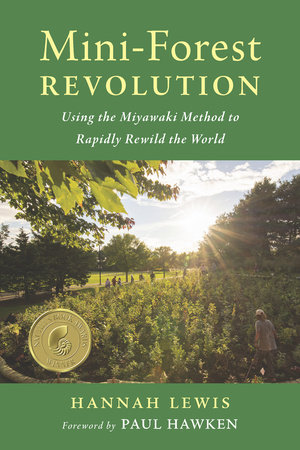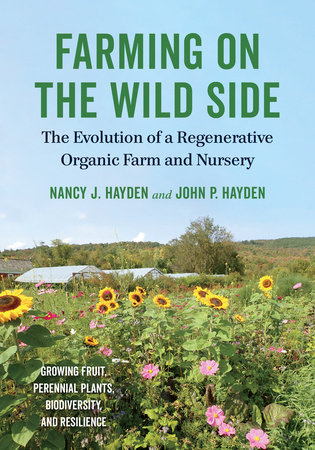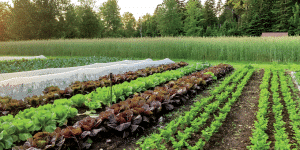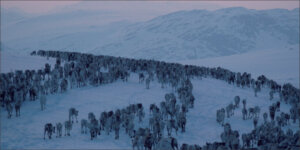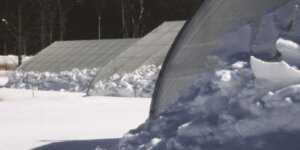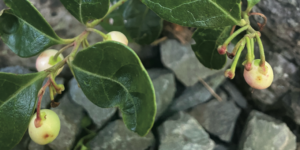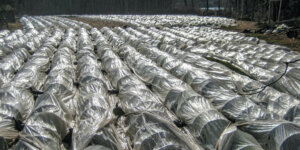Using The Miyawaki Method: A Forest in the Desert
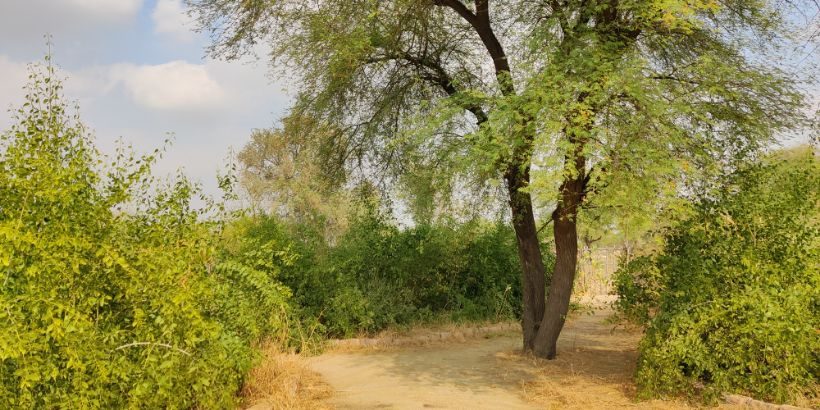
Growing a forest on barren, dry land calls for an innovative approach. This approach, known as the Miyawaki Method, transforms infertile land into a biodiverse oasis!
The following is an excerpt from Mini-Forest Revolution by Hannah Lewis. It has been adapted for the web.
Photo Courtesy of Gaurav Gurjar
History of the Miyawaki Method
When Afforestt’s Gaurav Gurjar was trying to identify local species to plant in a patch of degraded, semiarid land in central Rajasthan, India, he studied old local paintings and poetry.
Immersing himself in this particular restoration project, Gurjar actually lives on site on a 30 ac. (12 ha) parcel of desert sandwiched between the 308 mi. (496 km) Luni River and one of its tributaries, the Meethadi.
He moved there in 2018 with his life and work partner Varsha Gurjar, Afforestt’s training and communication coordinator. The land was offered to Afforestt by a person who runs a school and animal shelter on an adjacent site.
Testing the Method
His intention was to allow the group to test the Miyawaki Method in an extreme environment and to start a native desert tree nursery.
Once established, the project, dubbed Maruvan (meaning “desert forest”), branched off from Afforestt to become an independent nonprofit.
When the Gurjars arrived, the sandy ground was almost completely bare, and thus quite literally a blank slate for experimenting with restoration in a dry environment.
Experimenting With Dry Environments
“Whenever we do a project for a client, we don’t have much scope for experimentation,” Gurjar explained to me during a video call. A young man with round glasses, Gurjar seems to be in his element at Maruvan, where he can study ecosystems processes every day.
“We only implement those ways of which we are sure, our standard ways of reforestation, and we can’t fail on these projects. So Maruvan was started with the view that we are free to fail. For that, we chose one of the most difficult lands. We wanted to grow forests in arid landscapes.”
The average annual rainfall in the area is 300 mm (12 in.), but it does not necessarily rain every year, and every twenty to thirty years flash floods wash the landscape down to its bedrock in spots, stripping the land of young and sparse vegetation.
Summer temperatures reach highs of 50°C (122°F), while lows in the winter are just above freezing.
When I asked Gurjar about trees, he responded by talking about water. Noting that the local hydrological cycle had been broken due to land degradation, Gurjar said his first task was to create a water-harvesting structure.
The Miyawaki Method: Water Harvesting
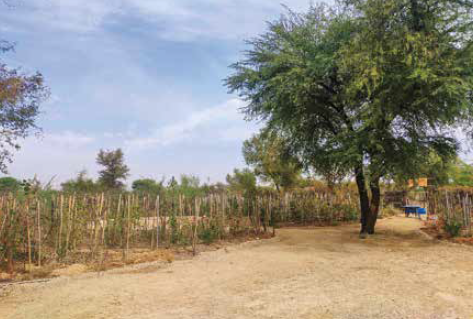
Gaurav Gurjar planted the Maruvan mini-forest in 2019 in the desert of Rajasthan, India. Courtesy of Gaurav Gurjar.
“You have to start somewhere,” Gurjar explained.
“If you start with the forest, then you have to externally bring water and then plant it. And once the forest develops, it creates a soil structure in such a way that whatever rain is falling, the soil is able to preserve that moisture in the root zone. But if you don’t have water, what will you start with? We started here with water.”
Gurjar studied traditional well and pond designs, which desert communities throughout Rajasthan have used for thousands of years to collect and stock water to make it through long rainless periods.
Designing A Water Source
Designs vary according to local geology and ingenuity.
After some experimentation, the Maruvan team settled on an open well 6.7 m (22 ft.) deep so as to avoid tapping into the groundwater, which is saline and unsuitable for consumption by plants or people.
Instead, the sajja ka kuva well, as it is known in local language, harvests subsoil water seeping through horizontal veins in the ground; this water enters through the spaces between the bricks that form the sides of the well and are not sealed with mortar.
Subsoil water is in turn fed by a .4 ha (1 ac.) pond the team has dug, along with a channel to connect it to the seasonal river.
The pond and well filled up the following monsoon season, providing about eight months of water with which the first Miyawaki-style forest patches could be planted.
Expanding the Network
Maruvan later expanded the network of ponds, channels, and open wells, anticipating that it would provide enough water to last through two or three years without rain. The water from the ponds seeps beyond the banks underground, eventually reaching the well.
“We’ll be studying horizontal movement of water—how far the moisture travels horizontally in the soil,” Gurjar explained.
“On those horizontal zones, we’ll be planting forest. Our target is that we should not need irrigation, because in the desert nobody irritates the soil—that’s not how the trees naturally grow. But to achieve that natural system, first we have to have the natural water systems that can sustain those forests.”
Gurjar’s Afforestt staff title of Jungle Tree Expert is not for nothing, given his clear knowledge of plants, although he could also be called Drylands Ecosystem Expert.
The Power of Observation
A year before moving on site, he started observing what was happening on the land and what species were present. “I used to sit here for six or seven hours in extreme heat—I used to sit under a tree and just observe what the ants were doing, what the dung beetles were doing, what the hoverflies or dragonflies were doing.”
Close-up observations like these have led Gurjar to important discoveries, such as how to get an important local tree to germinate.
When Gurjar had first tried to germinate jaal tree (Salvadora persica) seeds collected directly from the plant, it did not work.
“Just out of chance,” he explained, “I identified a spot where a lot of bulbul and house sparrow birds sit, and beneath them I found a lot of the seeds were germinating. When I observed their excreta, I saw that there were seeds. Then we started collecting those seeds, and when we germinated them, within one or two days they sprouted up.”
The Miyawaki Method: Bird & Plant Relationships
Gurjar was able to recognize another bird-plant relationship thanks to the poetry written decades earlier by a local Marwari poet (Marwari refers to the people of the Jodhpur region of southwest Rajasthan).
Among 700 verses describing local plants, animals, and their interactions is a verse about the daabh grass (Desmostachya bipinnata) nests constructed by weaver birds.
Neither species was to be found at Maruvan, however, until Gurjar decided to remove invasive Prosopis juliflora plants, which is a type of mesquite native in the Americas.
“When we removed the non-native species, that grass automatically returned,” Gurjar said. “And as soon as that grass came, weaver birds came flocking to our land. Right now, in my balcony where I’m sitting, I have fifteen to twenty nests that are being created in front of me by the weaver birds. And then the villagers all came saying, ‘Okay, this bird has come back after having been missing for forty years on this particular land.’”
The Beginnings of A Mini Forest

The Maruvan mini-forest circles two years later, in 2021. Courtesy of Gaurav Gurjar.
Maruvan’s first Miyawaki mini-forest patch included forty-four species determined by studying the Luni River basin environment throughout the region, the botanical poetry mentioned above, and local art.
Art displayed in a temple a couple of miles from Maruvan depicts an event that occurred in 1730, wherein the king’s men killed 363 people as they defended large khejri trees (Prosopis cineraria) that the king desired cut for the construction of a palace.
“Paintings in the temple are of these large trees, where the women are hugging the trees,” Gurjar explained.
Art of The Miyawaki Method
Similarly, he added, paintings in a nearby fort show the king hunting in the area.
Dense vegetation, huge trees, birds, and leopards depicted in these scenes are painted in such detail that individual species can be identified.
These old works of art suggest how the vegetation of this area might have looked before the land became degraded.
Gurjar explained that over time, the harvesting of large, slow-growing trees was so great that a tipping point was eventually reached.
The hundreds of saplings that would have grown up under the shelter of a single tree canopy could not endure the otherwise extreme conditions, and the cycle of renewal was broken.
The Tipping Point
If tree cutting started the desertification process, then overgrazing, sand mining, and non-native species introductions finished it off.
Even in a healthy state, the vegetation of a semiarid environment differs from that of humid forests elsewhere in India.
Gurjar has observed that desert vegetation grows in dense, scattered clusters of grasses, shrubs, and vines around one or two trees. The shrubs preserve enough moisture for the trees to grow.
Modeling this structure, the Gurjars and volunteers from the local village planted the forests in circular clusters of four to five seedlings per square meter, each circle spaced apart by a foot or two.
With each successive planting and ongoing observation, Gurjar has whittled down the species list to the most hyper-local adapted plants.
“These ecosystems are so complex that just 100 m. [328 ft.] from where I’m sitting, the vegetation or guild could be different,” he said.
The result is that the second and third groves, planted with thirty-five and twenty-five species, respectively, have demanded less water than the first, which presumably includes species adapted to slightly different conditions elsewhere in the region.
By connecting the land to the river and favoring the best-adapted species, Gurjar seems to be on his way to fixing a broken local water cycle.
Recommended Reads
Recent Articles
You know of Dasher, Dancer, Prancer & Vixen. Comet, Cupid, Donner & Blitzen. Rudolph too! But have you heard of the Sámi people who herd reindeer in Norway?
Read MoreNo heated greenhouse? No problem! Discover the secrets to thriving winter gardening without breaking the bank.
Read MoreWintergreen is the stunning evergreen groundcover that’s a game-changer for your garden! It’s cherished for its aromatic leaves, vibrant fall color & bright berries.
Read MoreYear-round growth without the hefty price tag of a greenhouse? Low tunnels are the cost-effective and flexible solution you’ve been looking for. Grow year-round with low tunnels!
Read More

